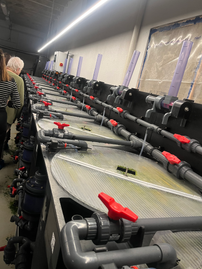Microalgae in Iceland
- Jags Pandhal

- Sep 9
- 2 min read
Updated: Sep 10
Jags Pandhal
I was really lucky to participate in my first EIT sponsored "algae school" last week in Iceland. The event was organised extremely well, based at the Government run, non-profit Research Institute, Matis. The first day was filled mostly with presentations and opportunities to network, where we got to hear about some of the research taking place across academia and industry in algal biotechnology, relevant to the food industry. These talks covered a breadth of subject areas, including microalgae, seaweeds, regulatory hurdles and economic assessements. The work by Iceborea was particularly interesting, where they are developing sprayable, edible bioplastics for use on vegetables like cucumbers. No need for single-use, petroleum sourced plastics. Interestingly, they were using spent biomass from Algalif, an excellent example of resource use of by-products.

We also visited MARS (not the red planet obvs.), it's an Aquaculture Research Facility, where trials are being undertaken with fish such as the Atlantic Salmon (that's why they are pink!) and new algal feeds. We also got to see the Marine & Freshwater Research Institute in Hafnafjörður, where they track and research local strains, with data spanning many decades. It was interesting to see any links between volanic eruptions and algal blooms.
The highlights were the industry visits, seeing the large-scale flat panels and bubble columns at VAXA powered by volcanic geothermal energy and cooled by glacial water. We got to sample Spirulina pesto and bread, as well as phyocyanin-blue ice-cream. The tubular reactors at Algalif were a sight to behold, and they are also developing downstream processing facilities here, rather than shipping to other countries with well-established processing operations.
Overall, the industrial visits were excellent, and I have to thank both for great hospitality, and especially Algalif for being so open when being asked questions. The products being developed here are all high value omega-3's for aquaculture and nutrition, phycocyanin pigments for nutrition, as well as the red astaxanthin as anti-oxidant pills and fish feed. Due to high salary rates in Iceland it was clear that automation is the way forward here, everything was monitored and controlled, the facilities spotless. And despite the fact that electricity is cheap (think of all those LED's!) and that cooling can be undertaken with glacial water, it still seems that the target products are still high value compounds.
What does this mean for us? In my opinion, algal biotechology is a very regional specific technology- what works in Iceland, might not work in Sheffield or Central Europe or South East Asia and so on. Each place has its own advantages and disadvantages, so solutions to making an economically viable algal biotechnology industry will ultimately be bespoke. What your local conditions are, what products are desirable etc. What we can say for sure is that these places in Iceland act as an inspiration for making a more sustainable manufacturing future, focussed on using photosynthetic microorganisms.





































Comments